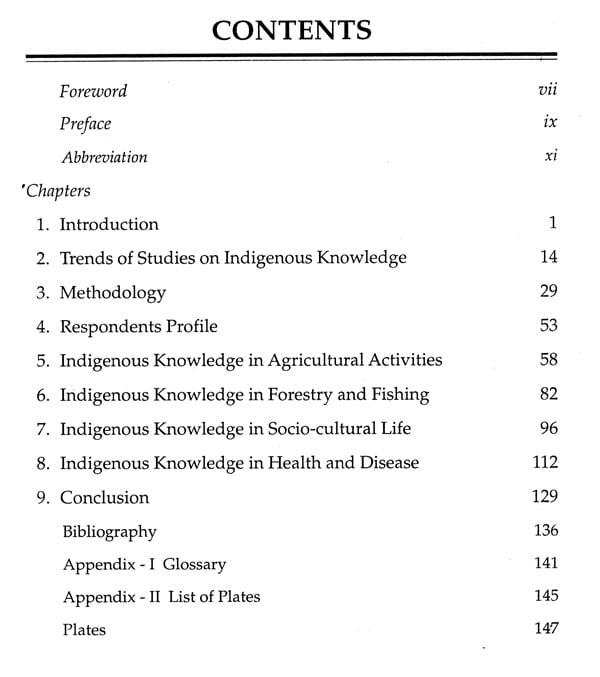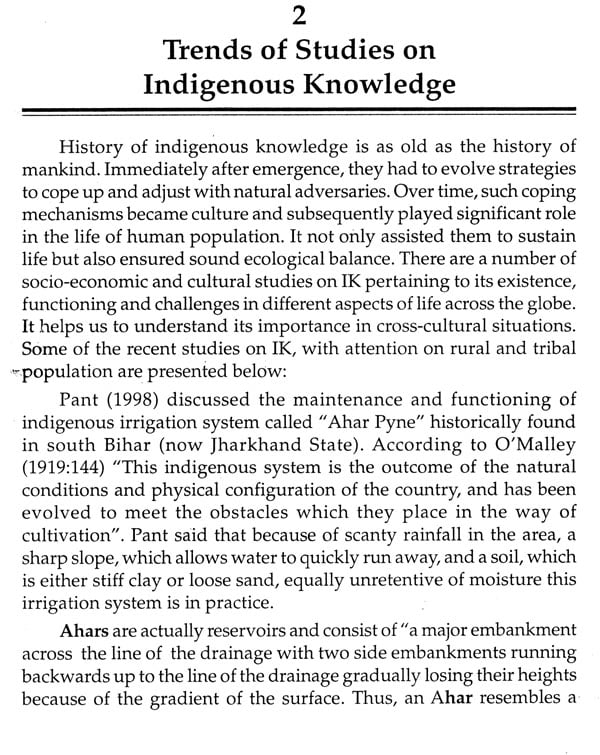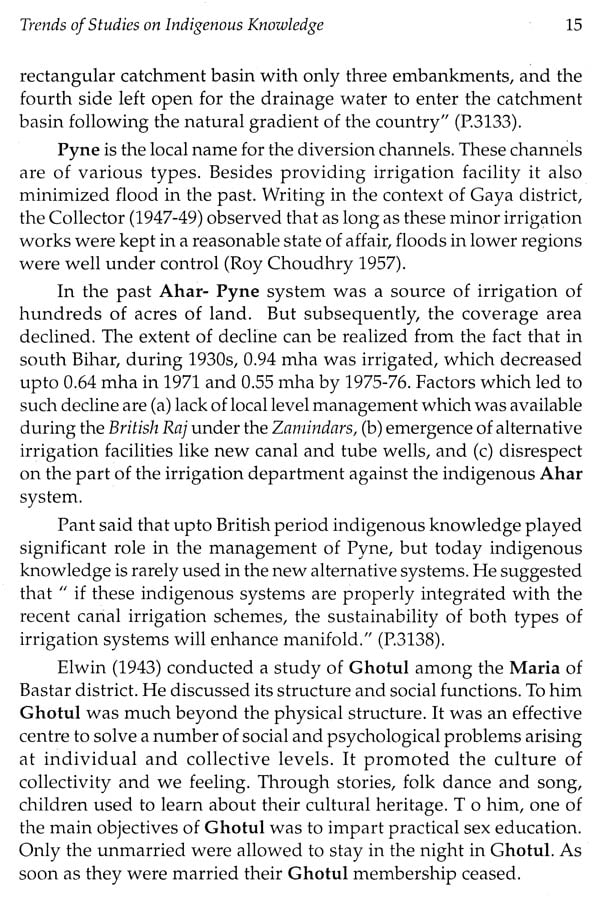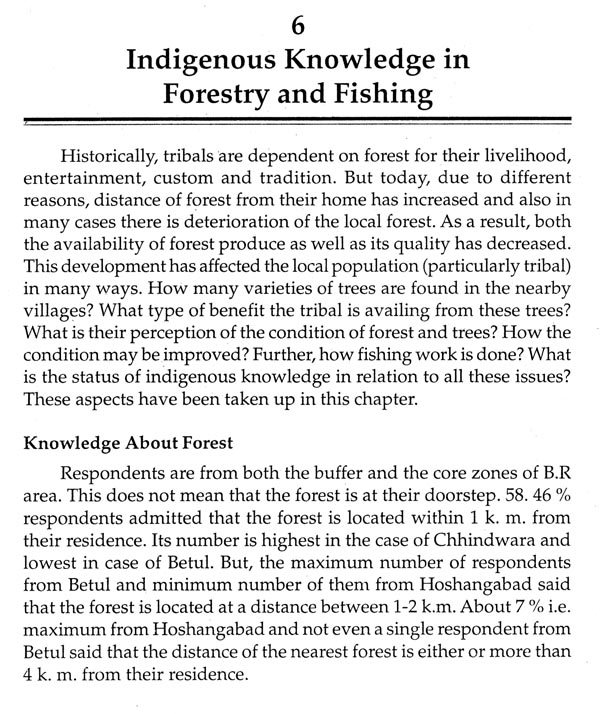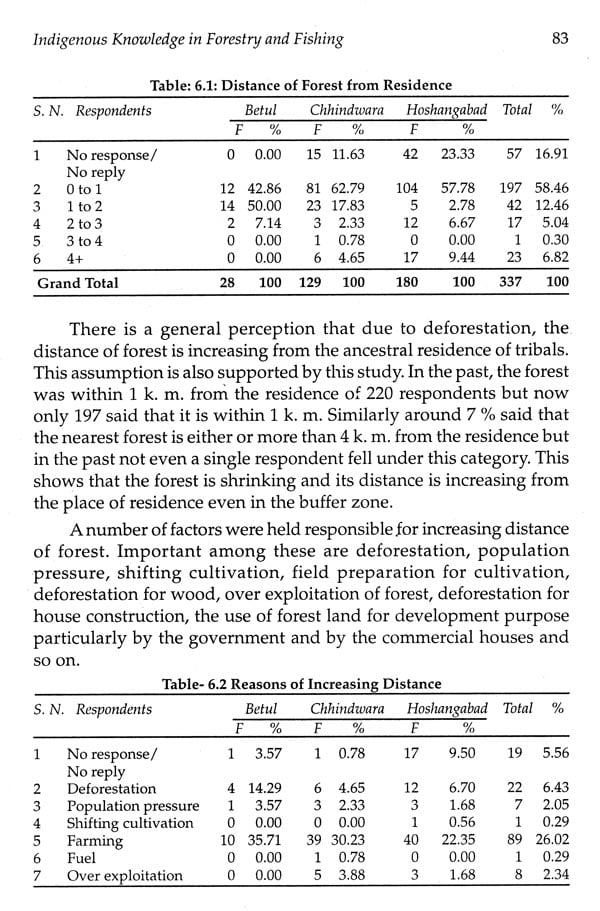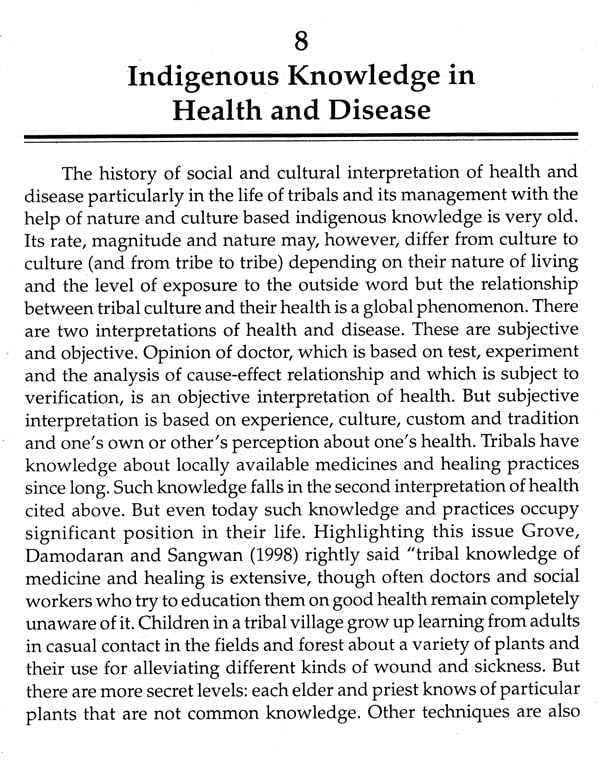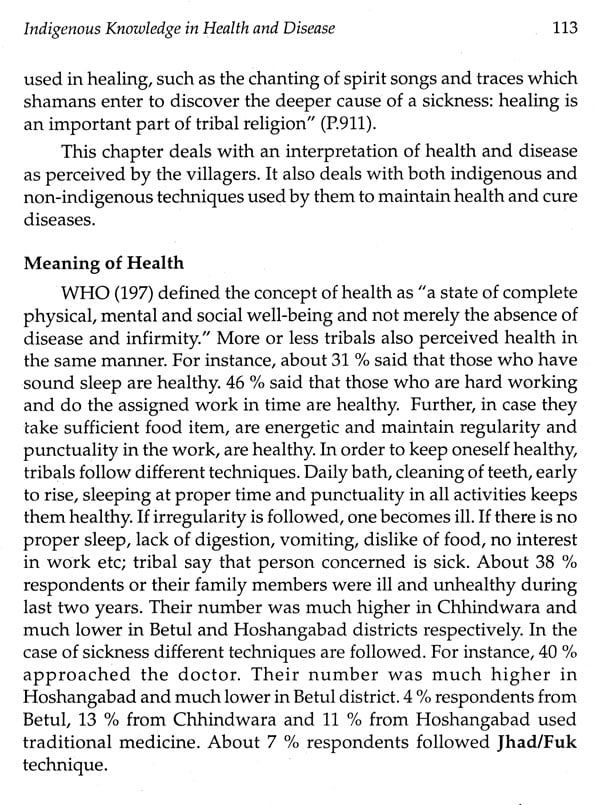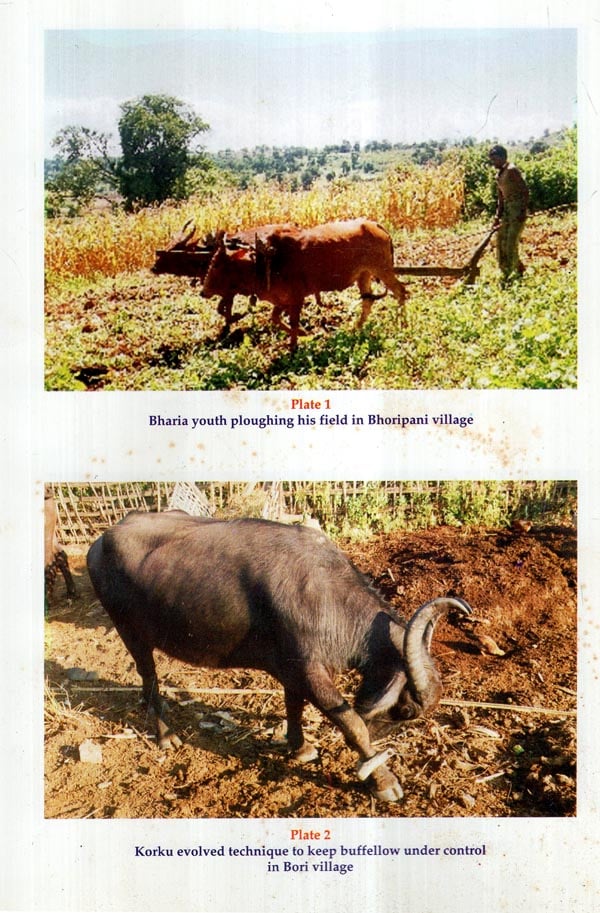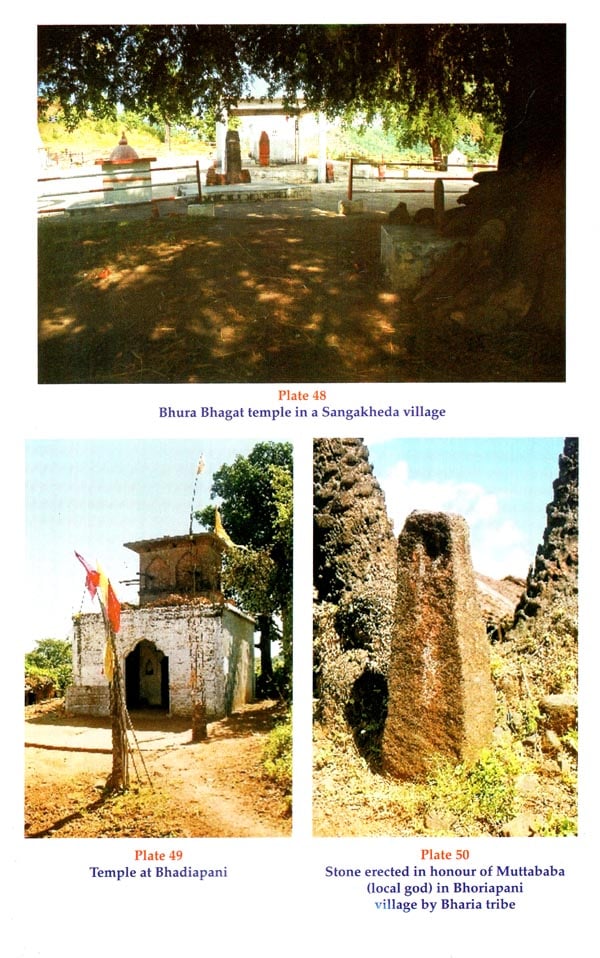
Tribes of Pachmarhi Biosphere Reserve and Their Indigenous Knowledge
Book Specification
| Item Code: | NAY718 |
| Author: | S. N. Chaudhary and R. P. Singh |
| Publisher: | Pratibha Prakashan |
| Language: | English |
| Edition: | 2006 |
| ISBN: | 9788177021240 |
| Pages: | 170 (56 Color Illustrations) |
| Cover: | HARDCOVER |
| Other Details | 10.00 X 7.50 inch |
| Weight | 660 gm |
Book Description
Like other Biosphere Reserve, the Pachmarhi Biosphere Reserve in Madhya Pradesh is the abode of various tribal groups. Indigenous. knowledge has been playing a significant role in the life of Gond, Korku and Bharia tribes living in the Pachmarhi Biosphere Reserve in spite of their increasing exposure to the outside world.
This book documents the role of such indigenous knowledge of the aforesaid ethnic groups in the management of agriculture, forest and fishing, health and diseases as well as their socio economic life. The study reveals that the amount of conflict is low and integration and adjustment between the modern knowledge and indigenous knowledge is high. Further, it is inferred that, if properly managed, indigenous knowledge can play a vital role in their sustainable development.
Dr. S.N. Chaudhary, a former fellow of A.N. Sinha Institute of Social Studies, Patna, Indian Institute of Advanced Study, Shimla and SMH Paris, is Professor of Sociology at Barkatullah University, Bhopal. He has conducted fieldwork among Red Indians in Canada. He has completed 20 research projects, written 23 books and 40 articles in professional journals. He has produced 22 Ph-Ds. Currently he is working on Culture and Crisis Management and Gains and Pains of Globalization : The case of Marginalized.
Dr. R.P. Singh is a Senior Research Officer at Environmental Planning and Coordination Organisation (EPCO), Bhopal since 1982. He is also Officer-in-Charge of Biosphere Reserves and is responsible for implementation of Management Action Plan of Pachmarhi Biosphere Reserve and Achanakmar-Amarkantak Biosphere Reserve. He has participated in different trainings, workshops and seminars at the national and international levels. Being project Coordinator, he has completed number of studies and research projects. Most of his studies deal with natural resources management and environment issues. He has published 15 research papers and prepared more than 40 research project reports.
Like the coin development has also two sides. It has produced both gains and pains. Due to the ongoing modernization model of development, all over the world, human population in particular have made tremendous progress and attained achievement in different realms. But at the same time it has also paid price of this development. Environmental degradation and ecological crisis is an example of such price.
This does not mean that at the collective and institutional level there is no effort to encounter such challenges although scholars can differ on the achievements of such encounters. Declaration of biosphere reserve is one of the serious institutional efforts to solve ecological crisis by discouraging deforestation, hunting and other forms of human encroachment in the concerned physical area of forest.
There is every possibility of human habitation under the biosphere area-no matter whether it is "core zone" or "buffer zone". In the case of PBR mainly it is tribal population who reside in large number. How to encourage friendly relationship between the local ecology including tribal population is a question which needs attention. The present study is an attempt to deal with such broader issues. For this purpose number of studies are required but this study is very specific in nature. It intends to explore their traditional knowledge, which is most often, unwritten and exist in oral tradition, in relation to different aspects of life such as agriculture, forest, fishing , health, social and religious life. Importance of this study is very significant during the IPR regime which has been formally initiated since 1991 with the introduction of New Economic Policy (NEP) in India.
The purpose of this study is to document such knowledge so that in the due course some of these may be protected and some may be strengthened for its further use in the years to come. It is needless to mention that due to limited level of access to the so-called modern resources it would be difficult for locals to adjust with the outside impact and can avail benefit. Contrary to this it can also be apprehended that due to widening of globalization these resources, including indigenous knowledge, may be either wither away or it may be taken away by others resulting thereby further deterioration in their life.
Hopefully present study will help the state in particular and others who have concern for tribal in general to protect and promote tribal with the help of their indigenous knowledge.
Ministry of Environment and Forests, GOI, New Delhi sponsored the study. We extend our sincere gratitude and thanks to the Ministry in particular and concerned officials in general for sanctioning the project and timely release of the sanctioned grant. Executive Director of EPCO, Bhopal needs special appreciation for extending cooperation and encouragement for the successful completion of the project.
We are highly oblised and thankful to Professor K.K. Basa, Director of IGRMS for accepting our manuscript under the series on Intangible Cultural Heritage of India published jointly by IGRMS, Bhopal and Pratibha Prakashan, Delhi.
D. N. Yadav and Ajay Shrivastava worked as Research Fellow in the project. They took pain to collect information from the remote villages and stayed there continuously for months. We are equally thankful to both of them. R.P. Singh (DFO) in charge of PBR and other officials helped us in the selection of villages and collection of information. We extend our sincere gratitude to all of them. We are also thankful to Bhopal and Patalkot office of M.P. Vigyan Sabha for extending needful co-operation and a couple of photographs. Last but not the least we are thankful to all the villagers who took part in the study either as respondents or as key informants. We are also thankful to Shri Arvind Saxena and Shri Manoj K. Sharma, Research Scholars in the Department of Sociology, Barkatullah University and Dr. Yashpal Singh and Mr. Rajnish Rai of EPCO for their help in the preparation of the report.
Indigenous Knowledge (IK), also known as traditional knowledge, plays a significant role in the life and works of social groups constitutionally called Scheduled Tribes. The present book, written by Prof. S.N. Chaudhary and Dr. R.P. Singh and based on the indigenous knowledge of three main tribal groups viz. Gond, Korku and Bharia living in the Pachmarhi Biosphere Reserve of Madhya Pradesh, is yet another interesting addition (No. 4) to our series on Intangible Cultural Heritage of India. On the basis of their fieldwork, the authors have discussed such indigenous knowledge systems with regard to agriculture, forestry and fishing, socio-cultural life, as well as health and disease. Even during the present time of rapid modernization and globalization, tradition and modernity, in case of the three main tribal groups living in and around Pachmarhi Biosphere Reserve, go hand in hand in some spheres while in most other spheres traditional knowledge is their main forte. Documentation of such indigenous knowledge system is necessary in the face of their steady erosion from the collective memory.
It is sincerely hoped that the present book would be a useful source for traditional knowledge systems of central India. This could be utilized variously by connoisseurs of heritage, planners and policy makers who have interest in tribal studies and development.
Partly because of the growing concern for local population living in rural and tribal areas across the globe, expansion of modernization led globalisation process upto the level of tribal villages and partly due to the realisation of the fact that the model of development is less gainful and more painful for local populations, particularly those living in the forest and mountain areas due to near failure of the early stages of development from their point of view such as the stages of economic growth, growth with equity, basic needs, participatory development and now sustainable development there is debate on indigenous knowledge possessed by the locals and its use and importance in the management of their life chances. This thinking has fastened the on going process of documentation, comprehension and dissemination of such knowledge for their use and also for its use by the wider society. Today, a number of international institutions such as CIDA, IDRC, UNESCO, and the World Bank are engaged in the promotion of IK in different ways. Also, in the past, IK was the subject matter only in a few disciplines, but now it is studied in various disciplines. Warren (1993) rightly said: "Ten years ago most of the academics working in the area of indigenous knowledge represented Anthropology, Development Sociology and Geography. Today important contributions are also being made in the fields of Ecology, Soil Science, Veterinary Medicine, Forestry, Human Health, Aquatic Science, Management, Botany, Zoology, Agronomy, Agricultural Economics, Rural Sociology, Mathematics, Fisheries, Range Management, Information Science, Wildlife Management, and Water Resource Management."
It is needless to mention here that indigenous knowledge is an integral part of the local ecosystem. It plays a vital role in social and economic life at the local level. Sankaran (2005) rightly observed "indigenous knowledge usually covers traditional and tradition based cultural expressions in forms such as stories, music, dance, artworks and crafts, including expressions of traditional concepts. It is knowledge handed down from one generation to another through oral/ written tradition, and that suggests a sense of common or communal ownership. It is the systematic body of knowledge acquired by local people through the accumulation of experience, informal experiment and intimate understanding of local conditions and provides a productive context for activities designed to help the communities."
Failure of technological might and institutional model of development in dealing with the problems of common people, particularly in the third world, local knowledge and technology, perceived as indigenous knowledge, are viewed as the best strategy in the old fight against hunger, poverty and underdevelopment. In the 1950s and 1960s, theorists and development practitioners perceived indigenous knowledge as inefficient, inferior and an obstacle to development. But today, due to harmonious relations between the holders of indigenous knowledge and the nature from the management of latter from sustainable point of view the importance of IK have increased and it has also been realized by the global power forces.
Today, IK represents a shift from a preoccupation with the centralized, technically oriented solutions of the past decades that failed to alter life prospects for a majority of the peasants and small farmers in the world. By highlighting the possible contribution of the knowledge possessed by the marginalized poor, current writings force attention and resources towards those who most need them.
This chapter deals with three issues. At first, it presets briefly the concept of tribe. The second deals with the concept of indigenous knowledge. The third deals with history of interface between tribals and their indigenous knowledge. It also deals with challenges before indigenous knowledge in the contemporary situation as well as its relevance in the life of those tribals who still live in the forests and mountains and have only occasional exposure to outside world and market forces.
Concept of Tribe
It is difficult to define tribe. Generally, it is perceived as a social group of a simple kind, occupying a common territory, speaking a common dialect, marrying within itself and having a cultural homogeneity. According to Roy Burman (1993) scheduled tribes is an administrative political category created under article 342 of the Constitution of India. However, the Constitution has not laid down any criteria for specification of communities as Scheduled Tribes. The first Backward Classes Commission which was appointed in 1953 by the President under provision in article 340 of the Constitution, however, stated that the Scheduled Tribes lead a separate exclusive existence and are not fully assimilated in the main body of the people. They may belong to any religion. They are listed as Scheduled Tribes, because of the kind of life they lead. Subsequently in the due course many scholars and administrators have defined the concept of tribe. Important among these are: Sengupta, 1988: Pathy, 1984: Beteille; 1986: Sahlins; 1968, Roy Burman; 1979, Singh; 1991; and so on.
Singh (1991) said that the concept of a tribe is a creation of a colonial period. It is a relatively homogenous social category. Xaxa (1999) also said that, "Tribals have come to be defined by the features of a segmentary system. This means that tribes are conceived of not only as small in scale but also as representative of a structural type which is quite different from the more complex social system in which the peasantry and gentry coexist. Ideally then, tribal societies are small in scale, restricted in the spatial and temporal range of their social, legal and political relations and in possession of a morality, religion and worldview of a corresponding order. In short tribal societies are self-contained units" (p.1523).
But today, due to a variety of reasons tribes are not homogenous. There is class formation among them. Their level of development and amount of exposure to outside world is also different. Many of them live in villages but their positive reference group is the modern or urban culture. Many of them have experienced sea changes in their food habit and dress pattern. And the process of such change is very old. In this situation only the ideal types of their features and their culture may be traced. But still, most of them depend on local level natural resources for their survival. And for the management of these resources particularly land and forest, indigenous knowledge is needed. Hence, even today, in spite of having relative heterogeneity, indigenous knowledge plays crucial role in the life of a majority of tribes.
**Contents and Sample Pages**
